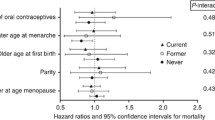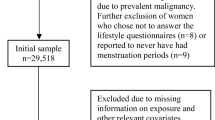Abstract
Background
While menopausal hormone therapy (MHT) is an established endometrial cancer risk factor, its relationship with mortality among endometrial cancer patients is understudied.
Methods
Within the NIH-AARP Diet and Health Study, we examined the associations of pre-diagnosis MHT use with 10-year all-cause and endometrial cancer-specific mortality among 890 endometrial cancer patients. We used Cox proportional hazards regression models to estimate hazard ratios (HRs) and 95 % confidence intervals (CIs) adjusted for tumor characteristics, treatment, and other risk factors.
Results
Endometrial cancer cases were diagnosed a median of 4.6 years (range 0.0–10.1 years) after the second risk factor questionnaire was completed. We identified a total of 241 deaths, of which 104 were due to endometrial cancer. Compared with non-MHT use, pre-diagnosis use of estrogen plus progestin therapy (EPT)-only was associated with lower 10-year all-cause (HR 0.65, 95 % CI 0.43–0.99, based on 29 deaths) and endometrial cancer-specific mortality (HR 0.51, 95 % CI 0.26–0.98, based on 11 deaths). Recency of MHT use, assessed approximately 5 years prior to the endometrial cancer diagnosis, was associated with mortality. Compared with non-MHT users, former ET users had higher all-cause (HR 1.71, 95 % CI 1.02–2.88, based on 18 deaths) and endometrial cancer-specific mortality (HR 2.17, 95 % CI 0.96–4.90, based on 8 deaths), whereas current EPT users had nonsignificant lower risks of death.
Conclusion
Based on small numbers, we observed that pre-diagnosis use of EPT was related to lower mortality among endometrial cancer patients. Future studies examining the biological mechanisms underlying this association are warranted.
Similar content being viewed by others
References
Brinton LA, Felix AS (2014) Menopausal hormone therapy and risk of endometrial cancer. J Steroid Biochem Mol Biol 142:83–89
Grady D, Gebretsadik T, Kerlikowske K, Ernster V, Petitti D (1995) Hormone replacement therapy and endometrial cancer risk: a meta-analysis. Obstet Gynecol 85(2):304–313
Trabert B, Wentzensen N, Yang HP, Sherman ME, Hollenbeck AR, Park Y, Brinton LA (2013) Is estrogen plus progestin menopausal hormone therapy safe with respect to endometrial cancer risk? Int J Cancer 132(2):417–426
Beral V, Bull D, Reeves G (2005) Endometrial cancer and hormone-replacement therapy in the Million Women Study. Lancet 365(9470):1543–1551
Robboy SJ, Bradley R (1979) Changing trends and prognostic features in endometrial cancer associated with exogenous estrogen therapy. Obstet Gynecol 54(3):269–277
Smith DC, Prentice RL, Bauermeister DE (1981) Endometrial carcinoma: histopathology, survival, and exogenous estrogens. Gynecol Obstet Invest 12(4):169–179
Petitti DB, Perlman JA, Sidney S (1987) Noncontraceptive estrogens and mortality: long-term follow-up of women in the Walnut Creek Study. Obstet Gynecol 70(3 Pt 1):289–293
Underwood PB Jr, Miller MC, Kreutner A Jr, Joyner CA, Lutz MH (1979) Endometrial carcinoma: the effect of estrogens. Gynecol Oncol 8(1):60–73
Collins J, Donner A, Allen LH, Adams O (1980) Oestrogen use and survival in endometrial cancer. Lancet 2(8201):961–964
Chu J, Schweid AI, Weiss NS (1982) Survival among women with endometrial cancer: a comparison of estrogen users and nonusers. Am J Obstet Gynecol 143(5):569–573
Schwartzbaum JA, Hulka BS, Fowler WC Jr, Kaufman DG, Hoberman D (1987) The influence of exogenous estrogen use on survival after diagnosis of endometrial cancer. Am J Epidemiol 126(5):851–860
Paganini-Hill A, Ross RK, Henderson BE (1989) Endometrial cancer and patterns of use of oestrogen replacement therapy: a cohort study. Br J Cancer 59(3):445–447
Orgeas CC, Hall P, Wedren S, Dickman PW, Czene K (2009) The influence of menopausal hormone therapy on tumour characteristics and survival in endometrial cancer patients. Eur J Cancer 45(17):3064–3073
Schatzkin A, Subar AF, Thompson FE, Harlan LC, Tangrea J, Hollenbeck AR et al (2001) Design and serendipity in establishing a large cohort with wide dietary intake distributions : the National Institutes of Health-American Association of Retired Persons Diet and Health Study. Am J Epidemiol 154(12):1119–1125
Michaud D, Midthuner D, Hermansen S, Leitzmann MF, Harlan LC, Kipnis V, Schatzkin A (2005) Comparison of cancer registry case ascertainment with SEER estimates and Self-reporting in a subset of the NIH-AARP Diet and Health Study. J Regist Manag 32(2):6
Zaino RJ (2009) FIGO staging of endometrial adenocarcinoma: a critical review and proposal. Int J Gynecol Pathol 28(1):1–9
Hermansen SW, Leitzmann MF, Schatzkin A (2009) The impact on National Death Index ascertainment of limiting submissions to social security administration death master file matches in epidemiologic studies of mortality. Am J Epidemiol 169(7):901–908
Lacey JV Jr, Brinton LA, Lubin JH, Sherman ME, Schatzkin A, Schairer C (2005) Endometrial carcinoma risks among menopausal estrogen plus progestin and unopposed estrogen users in a cohort of postmenopausal women. Cancer Epidemiol Biomark Prev 14(7):1724–1731
Nelson HD, Humphrey LL, Nygren P, Teutsch SM, Allan JD (2002) Postmenopausal hormone replacement therapy: scientific review. JAMA 288(7):872–881
Creasman WT, Odicino F, Maisonneuve P, Quinn MA, Beller U, Benedet JL, et al. (2006) Carcinoma of the corpus uteri. FIGO 26th annual report on the results of treatment in gynecological cancer. Int J Gynaecol Obstet 95 Suppl 1:S105–43
Mittal KR, Barwick KW (1993) Endometrial adenocarcinoma involving adenomyosis without true myometrial invasion is characterized by frequent preceding estrogen therapy, low histologic grades, and excellent prognosis. Gynecol Oncol 49(2):197–201
Nyholm HC, Nielsen AL, Norup P (1993) Endometrial cancer in postmenopausal women with and without previous estrogen replacement treatment: comparison of clinical and histopathological characteristics. Gynecol Oncol 49(2):229–235
Shapiro JA, Weiss NS, Beresford SA, Voigt LF (1998) Menopausal hormone use and endometrial cancer, by tumor grade and invasion. Epidemiology 9(1):99–101
Chapman JA, DiSaia PJ, Osann K, Roth PD, Gillotte DL, Berman ML (1996) Estrogen replacement in surgical stage I and II endometrial cancer survivors. Am J Obstet Gynecol 175(5):1195–1200
Anderson GL, Judd HL, Kaunitz AM, Barad DH, Beresford SA, Pettinger M et al (2003) Effects of estrogen plus progestin on gynecologic cancers and associated diagnostic procedures: the Women’s Health Initiative randomized trial. JAMA 290(13):1739–1748
Matthews KA, Kuller LH, Wing RR, Meilahn EN, Plantinga P (1996) Prior to use of estrogen replacement therapy, are users healthier than nonusers? Am J Epidemiol 143(10):971–978
Hersh AL, Stefanick ML, Stafford RS (2004) National use of postmenopausal hormone therapy: annual trends and response to recent evidence. JAMA 291(1):47–53
Acknowledgments
This research was supported (in part) by the Intramural Research Program of the National Cancer Institute.
Conflict of interest
The authors declare that there are no conflicts of interest.
Author information
Authors and Affiliations
Corresponding author
Electronic supplementary material
Below is the link to the electronic supplementary material.
Rights and permissions
About this article
Cite this article
Felix, A.S., Arem, H., Trabert, B. et al. Menopausal hormone therapy and mortality among endometrial cancer patients in the NIH-AARP Diet and Health Study. Cancer Causes Control 26, 1055–1063 (2015). https://doi.org/10.1007/s10552-015-0598-0
Received:
Accepted:
Published:
Issue Date:
DOI: https://doi.org/10.1007/s10552-015-0598-0




